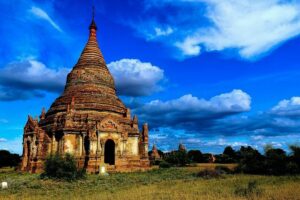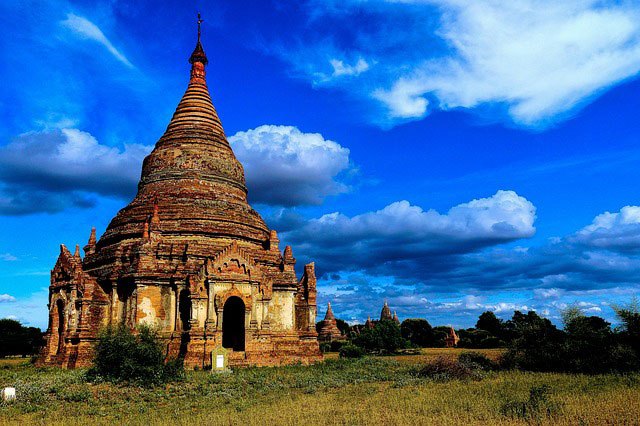Ever heard of purebred Burmese cats? What about Burmese wine and rubies? How about the golden pagodas, one of which is encrusted with diamonds? As Myanmar slowly opens its doors to tourists once again, these are many wonders you’ll be able to find there. But wait a second. Is it Burma or Myanmar? And what’s the difference between the two names for this south-east Asian country? Steeped in a lot of history and politics, let’s find out what the Myanmar meaning is by tracing back our footsteps right to the very beginning.
The origin of Myanmar is not easy to pin down. This is because the country has had quite a tumultuous past. From kings that tried to unite it and expand territories, to being considered a state of India for a period, all this while being a British colony. Then there was the Japanese invasion during World War Two and military regime after military regime, so explaining what Myanmar means is no easy task. Here’s a brief rundown of what you need to know about this country.
The early days
Tracing the beginnings of Burma can be a bit hard, but research indicates that the country’s Irawaddy valley had been inhabited over 3,500 years ago. The people at the time were engaged in rice farming, livestock raising, and utilizing instruments made of bronze. This all changed, however, in the fourth century, when Burma adopted South India’s Theravada style of Buddhism. To date, it is estimated that over 80% of the country’s people are Buddhist and, interestingly enough, it has the largest number of monks when compared to the percentage of the total population.
The rise of Burma
Moving forward to the ninth century, it is said that a group from the north called the Bamar established a kingdom. Known as Pagan or Bagan, the kingdom unified the administration and led to the unification of entire Burma by 1057. Successive kings that followed after king Anawrahta (also known as Aniruddha) continued this trend by building monasteries, pagodas, libraries, and colleges. They also improved the way water was harvested, which led to a spike in rice production. Given the geographical location of Burma, though, meant that the country was rather isolated from its neighbors. This meant that in the centuries that followed, there would be various divisions as different ruling powers rose and fell, with varying degrees of control.
The empire of Bayinnaung
In the mid-16th century, Bayinnaung emerged as a king with an expansionist policy. He gained a reputation for waging wars in order to acquire more and more land. In fact, his rule stretched to Burma, Thailand, and Laos, but this did not last long after his death in 1581.
Enter the British empire
In the late 18th century, the Anglo-Burmese War took place from 1825 to 1826, after which Burma was completely annexed and was viewed as a backdoor market for “lucrative trade with China.”
For a brief history of time – a part of India
Still, in the same century, Burma was made into a province of India in 1886. Due to British rule, many new changes were implemented, including the introduction of Indians to fill civil-service jobs. Chinese and Indian business interests in Burma were encouraged, and many Burmese felt resentment towards their captors. In the north, guerilla fighters tried to resist British rule, but they were suppressed with the destruction of entire villages.
Enter the new century
 We now shift forward in time by a few decades to 1920. This is when renewed resistance against British rule arose from protests by university students. This was followed by strikes and protests. Two of the students – Aung San and Nu – subsequently joined the “thakin” movement. This name translates to “master” and was used to describe the Burmese as colonial subjects.
We now shift forward in time by a few decades to 1920. This is when renewed resistance against British rule arose from protests by university students. This was followed by strikes and protests. Two of the students – Aung San and Nu – subsequently joined the “thakin” movement. This name translates to “master” and was used to describe the Burmese as colonial subjects.
World War Two
When World War Two started, Burma was separated from India. The “thakins” rejected participation in the war. Aung San subsequently co-founded the Burmese Communist Party. While on his way to Hainan Island in China for training with 29 other men, he realized that the Japanese had an interest in invading the country, which they subsequently did in 1942, and with this came the fact that one set of colonizers was replaced with another. To counter this, Aung San held negotiations with the British to drive out the Japanese, which took place in May 1945. Aung San was also one of the founders of the Anti-Fascist People’s Freedom League (AFPFL).
Freedom from British rule
Freedom from British rule happened in January 1947, when Aung San negotiated independence. He also reached an agreement with various ethnic groups for a unified state. In an elected interim government, Aung San won a majority of the seats and began drafting the country’s constitution. However, just seven months later, on 19 July 1947, Aung San and some members of his cabinet were shot down. Remember the student leader Nu we mentioned earlier? This was his time to shine. He took over the reins and Burma became independent on 4 January 1948. The country refused to join the British Commonwealth.
A short-lived democracy
With Nu at the helm, he faced many challenges. There were communist factions and ethnic groups that felt excluded. Insurgencies began, civil war in parts of the country followed as did widespread unrest. In 1958, the military took over for the first time under one of the thakins, General Ne Win. This “caretaker government” cleansed the country of “communist sympathizers” and compelled minority states to take heed of the central government. In 1960, elections took place and Nu came back as Prime Minister. However, a coup two years later under Ne Win took place and the country’s rule under military dictatorship started.
Rule under Ne Win
The path towards socialism was adopted at the expense of many freedoms. For example, the constitution was suspended, opposition political parties were banned, there was censorship of the media, and the country was essentially closed off from the world. Many human rights violations took place and all forms of unrest were crushed. All of the major sectors of industry were nationalized. This drove “the country to ruin”.
Ne Win steps down
Ne Win’s rule lasted from 1962 until July 1988 when he suddenly announced he would step down. Although there was hope for democratization in the summer of 1998, in August of the same year, crowds that had gathered to protest were gunned down. Meanwhile, Aung San’s daughter Aung San Suu Kyi was asked to join a democracy movement. In May 1990, multi-party elections were held, and while they were considered free and fair and Aung San Suu Kyi won an overwhelming majority, however “the military refused to hand over power.”
The road ahead
The road ahead looks unclear as it appears the people of the country are ready for democracy, although the path to achieving this goal is still unknown. It is mentioned that Burma’s civil war is now the longest-running in the world.
And back to the names
Myanmar culture and Burmese culture essentially refer to the same thing: ethnic minorities and ethnic majorities which try to live together. Although the name Burma is no longer used by the country’s officials because it tends to refer to the Burmans majority in power, and in efforts to unite the country’s people, Myanmar was chosen as the name for this state to be more inclusive. However, in terms of Myanmar culture and tradition or the culture of Burma, the names used by the local people to depict the country could have political undertones. In closing, while the country is now Myanmar, the language there is still Burmese and so is its unique script.
